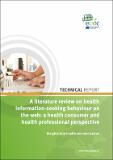A literature review on health information seeking behaviour on the web: a health consumer and health professional perspective.
Date
2011Author
Higgins, O
Sixsmith, J
Barry, Margaret M.
Domegan, C
Metadata
Show full item recordUsage
This item's downloads: 2385 (view details)
Recommended Citation
Higgins, O; Sixsmith, J; Barry MM; Domegan, C (2011) A literature review on health information seeking behaviour on the web: a health consumer and health professional perspective. ECDC, .
Published Version
Abstract
The purpose of this literature review is to provide an overview of research studies published from 2006 to 2010 in
the English language on online health information-seeking behaviour by adults from the perspective of both the
health consumer and the health professional.
Interest in the internet as a communication tool for health-related information is growing rapidly [1]. The profile of
online health consumers can be broadly defined as patients, patients friends/relatives, and citizens in general [2].
Health information-seeking behaviour varies depending on type of information sought, reasons for, and experience
of, searching [3]. Research shows that women are more likely than men to search for health information [4,5] and
online health consumers tend to be more educated, earn more, and have high-speed internet access at home and
at work [6,7]. Internet-based health information is accessed from a variety of sources, including websites run by
organisations, homepages run by individuals, and online support groups where people actively exchange health
information and blogs. As more people use the internet as a source of health information the issue of source
credibility and trust in websites becomes important [8].
Research shows that health professionals use of the internet to obtain health and medical information has
increased [9 11]. Furthermore, in a cross-sectional survey, 80% of physicians reported experience of patients
presenting printed internet-sourced health information at visits [12]. Thus, the traditional doctor patient
relationship is being challenged.
The internet is a resource available to an increasing number of European citizens but, as with other information
sources, differential access and use is apparent both within countries and between countries in the European Union.
A lack of research in the European context means that the potential of the internet as a source of health
information may not be fully understood. Nevertheless, the internet would appear to provide the ideal medium for
the provision of information targeted at the prevention and control of communicable disease for both health
consumers and health professionals in Europe.
Description
Report
URI
http://ecdc.europa.eu/en/publications/Publications/Literature%20review%20on%20health%20information-seeking%20behaviour%20on%20the%20web.pdfhttp://hdl.handle.net/10379/4588
Collections
Except where otherwise noted, this item's license is described as Attribution-NonCommercial-NoDerivs 3.0 Ireland
Related items
Showing items related by title, author, creator and subject.
-
Developments in health literacy over time: A longitudinal qualitative research study
McKenna, Verna (NUI Galway, 2019-12-12)Introduction Conceptualising health literacy as a relational concept, which involves how individuals interact with complex health and social systems, requires a greater understanding of the context of people’s health ... -
Toward international collaboration on credentialing in health promotion and health education: The Galway Consensus Conference
Barry, Margaret M. (SAGE Journals Online, 2009-05)The interest in competencies, standards, and quality assurance in the professional preparation of public health professionals whose work involves health promotion and health education dates back several decades. In ... -
Researching health inequalities in adolescents: The development of the Health Behaviour in School-Aged Children (HBSC) Family Affluence Scale.
Molcho, Michal (Elsevier, 2008)Socioeconomic inequalities in adolescent health have been little studied until recently, partly due to the lack of appropriate and agreed upon measures for this age group. The difficulties of measuring adolescent socioeconomic ...


